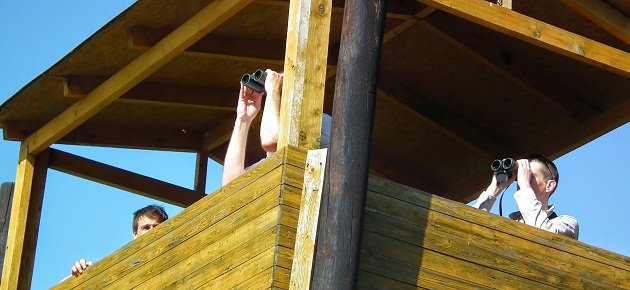
Instead of waiting for the spring to come to me, I prefer to travel south to greet it. (One may also read this as “those who paddle their own canoe do not have to wait for their ship to come in.”) This time I was lucky enough to join a fam trip organised by Natural Greece, an ecotourism company from Athens, and spend a few days at my favourite Kerkini Lake, which you already birded through my bins (April and September).
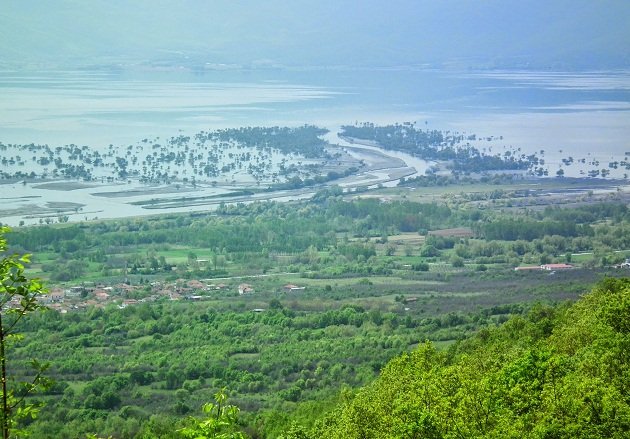 The northeastern part of the lake, where the river Strymonas flows into
The northeastern part of the lake, where the river Strymonas flows into
As it turned out, I was the only travel writer of the group. Beside Andrea Bonetti, the guide from Natural Greece, there were four more bird guides coming from some of the leading tour operators in the industry.
Picture 1: Siberian Greylag Goose – Anser anser rubrirostris
I have spent ages surveying waterfowl, a mere 600 kilometres further north and have never seen Greylags like this. The van was parked at the Eastern Dyke of the lake and we were scanning the mud flats and numerous Pygmy Cormorants, Dalmatian and Great White Pelicans with a few Greater Flamingos and Eurasian Spoonbills here and there, as well as one or two Purple and Black-crowned Night-Herons. Among them were Common, Green and Wood Sandpipers, Common Greenshanks and Ruffs… and those two strange looking Greylags. Instead of pale-orange, their beaks and legs were bright-pink.
I asked R. what does he think of them, and he said: “Let’s ask the others which race this might be”. A quick check of the Collins 2 (I think American birders know this book as the “Birds of Europe”, but here, some branding mastermind has interconnected the company’s name and the book title) revealed that we are facing two Siberian Greylag Geese (race rubrirostris).
Picture 2: Lesser Spotted Eagle – Clanga pomarina
Andrea was driving along the western shore of the lake when a large raptor appeared in front of us – Booted or Lesser Spotted Eagle? A hasty stop and a bunch of birders spilling out of a van. The Lesser Spotted it is and it glides off to a tall tree at the lake shore. Looking in that direction, we soon discover another LSE on the ground and, in a bush right in front of us, one lovely male Subalpine Warbler.
Andrea now veers onto a dirt track leading us up the hills of the Mavrovoyni/Krousia. Common Chiffchaffs are singing, a Hawfinch is in the nearest tree… and a large raptor in a steep glide with half-folded wings – one more Lesser Spotted Eagle! It lands on a bare branch inside the forest at the opposite slope of the valley, right next to another LSE and we observed more than we hoped for – a pair copulating.
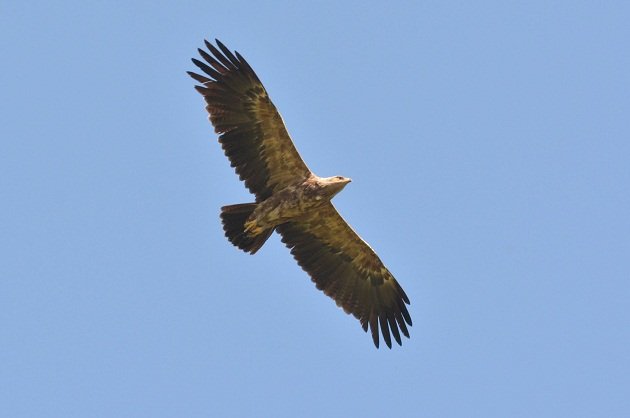 Lesser Spotted Eagle (c) by Laurens Steijn
Lesser Spotted Eagle (c) by Laurens Steijn
Yes, those were four eagles in 20 minutes.
Picture 3: Long-legged Buzzard – Buteo rufinus
Dusty road takes us into much higher Mt. Beles, north of the lake. At the Eastern Dyke we met a national park ranger who told us where to look, so now we carefully scan a particular area. The nest… looks like an old and unoccupied Common Raven’s nest… some motion above – several Eurasian Crag-Martins… action to the left: two Ravens chasing the Long-legged Buzzard! Closer, one Subalpine Warbler performs its display flights. Scan of the ridge reveals a distant but definitive Peregrine Falcon. And some more movements: very high, two or three Short-toed Eagles are soaring in the blue sky.
Picture 4: Common Cuckoo – Cuculus canorus
On our day one (April 17th), there were no Common Cuckoos to be seen, but on our day two, they were noticeable (the first song recorded, too). By the morning of 19th, they become so common that while driving along the Eastern Dyke, I had three of them together in front of me for quite some time, one of them a gorgeous rufous morph female.
Picture 5: European Scops-Owl – Otus scops
On the first evening, we were about to enter a disused railway station turned into a charming tavern, when I heard my first European Scops-Owl of the season, calling somewhere from the poplars in the darkness of the other side of a railway track.
Picture 6: Little Owl – Athene noctua
These cute little birds are common in the villages. While entering the Chrysochorafa last September, in some ten minutes we saw three. One was holding its head parallel to the ground, keeping an eye at the ever-lower flying Common Buzzard, and then hopping and disappearing in the hollow space between the bricks. The other one noticed our attention and just hopped to the other side of the roof, supposedly to hide from us, but being so curious, it had to poke its head up to see what we were doing. This April, we have seen one in the morning, but were also greeted by the Little Owl calling in the night, perhaps two roofs from our guest house.
Picture 7: Grey-headed Woodpecker – Picus canus
The banks of the Strymonas River are surrounded by dykes, especially its right, northern bank with three parallel dykes, all of them offering areas to explore and bird. This time, we were looking for woodpeckers.
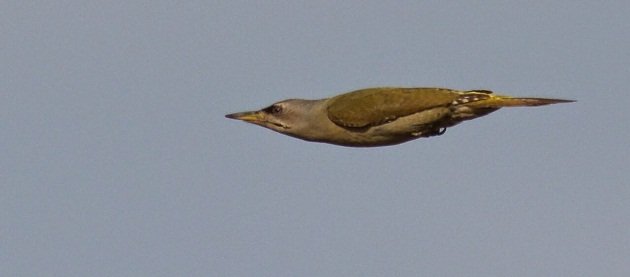 Grey-headed Woodpecker (c) by Laurens Steijn
Grey-headed Woodpecker (c) by Laurens Steijn
Habitats here include arable fields – my first Common Quail of the season was singing Wet-mi-lips from one of them, with small poplar forests – from where a characteristic call of the Eurasian Green Woodpecker came. The Syrian Woodpecker in flight, and the call of the Grey-headed Woodpecker… With some playback, the bird showed itself, soon joined by another and then even the third bird landed in the same tree-crown. Most of the time they were in the shade, but for some time, one of them was on the sunny branch. Should I add, this is my best sighting of this uncommon species – ever!
Picture 8: Sombre Tit – Poecile lugubris
Driving through the bushes of the lower slopes of Mt. Beles, I break for the lovely bright-yellow male Cirl Bunting, only to spot some movement through the dusty car window, one grey-headed and white-cheeked tit with a largish black bib – the not so common Sombre Tit.
Picture 9: Western Rock Nuthatch – Sitta neumayer
I am scanning the cliff next to the quarry by the town of Sidirokastro, some 15 km east of the Kerkini Lake. It is a lovely spot: its base is overgrown with pines and cypresses (one Serin was singing from the trees), but they are partially obscuring the view of the rock face. It didn’t take long to find what I was after – the one that I missed here the day before.
The Western Rock Nuthatch showed well for some 15 to 20 seconds while I used binoculars. At the moment I thought that it would stay and I should put up the scope, it disappeared. I waited and waited, but the wind got stronger and all the “rocks” hid in crevasses, not allowing for the second view.
Picture 10: Rock Sparrow – Petronia petronia
One day before, at the same quarry, we were hastily getting out of the van and, at the same time, it took N. – who probably got out first – less than five seconds to find a handsome male Blue Rock-Thrush! I know what you must be thinking – the bird was at the ridge, obvious against the sky – but it was not. It was at the lower ridge, obscured by the grey and black background of a cliff, yet it was no match for N.
Then I spotted an easy and obvious one, the Black-eared Wheatear, while the group climbing the steep hillside found the Rock Nuthatch of which I told you before, as well as the Rock Sparrow, striped, pale and indescribable. And a lifer for me – if I manage to see it!
P. came back and from some 50 metres and totally different angle, not to mention looking only at a small section of the rock face visible between the cypresses, managed to frame the indescribable bird in his scope field of view. I was amazed, both by the bird itself and his ability to find it.
Two intensive days of 12 birding hours each – with just one pit stop on day two, plus one leisurely paced morning yielded a list of 103 species (that is my personal list – the group list is a bit longer and includes a Golden Eagle that I’ve dipped).
I must admit, prior to this trip I’ve thought that guides are birders like the rest of us – only luckier, but that was naive. These guides are birders on steroids! And – since I know they will read this – guys, I take my hat off to you.
Many thanks to Chantel Kyriakopoulou-Beuvink and Nikos Gallios.
I travelled with: Natural Greece (www.natural-greece.gr/en).
And stayed at: Limneo Guest House (www.limneokerkini.gr/en).
For additional info, the BirdLife Greece has recently published the Greek bird finder.

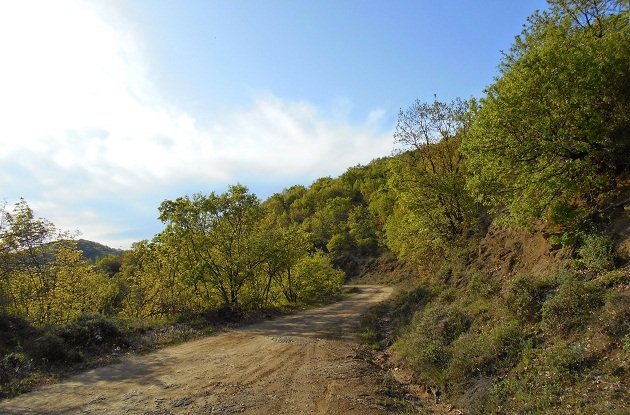
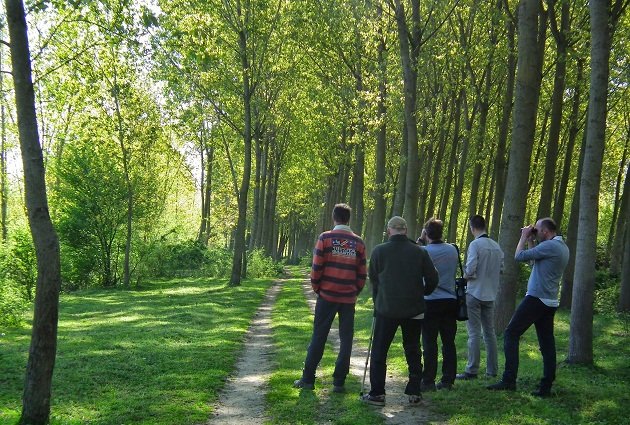
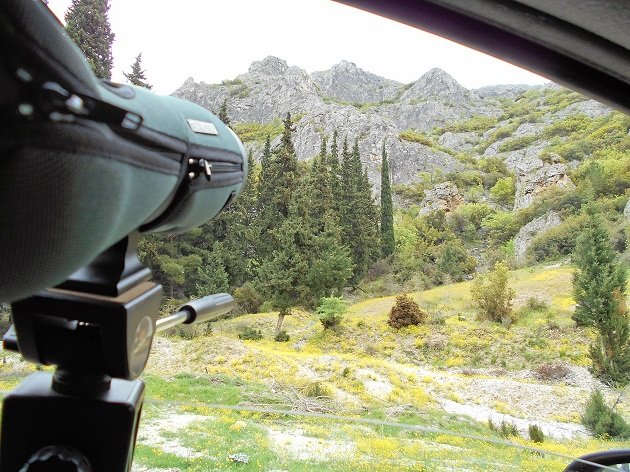










Leave a Comment